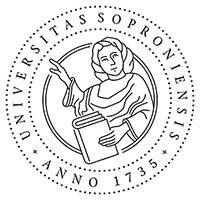The Starts of Conversational Competencein Infant and Early Childhood
Abstract
The aim of the paper is to present the evolution of conversational competence on the basis of a spontaneous textual corpus including mother-children conversations in a functional theoretical framework. After a short and general description of functional linguistics the second part presents a theoretical introduction to the acquisition of mother tongue. The forth part discusses the material and methods of the research: shows the features of the examined textual corpus, and displays the conversation analysis as the methodological framework of the paper. The next part goes into details through the analysis of textual corpus. This analysis tries to find the answers to the following questions: (1) How can the mother help the development of the conversational ability of her child with her communicative competence? (2) When do children start to use the following conversational strategies: turn-taking, self-selection, other-selection, sequence organization, interpolated sequence, side-sequence, organization of repair, other-initiated repair, self-initiated repair, overlapping?
References
Althaus, H.-Henne, H.-Wiegand, H. E. (Hrsg. 1980): Lexikon der Germanistischen Linguistik. Niemeyer, Tübingen. doi: https://doi.org/10.1515/9783110960846
Ammon, U.-Dittmar, N.-Mattheier, K. J. (eds. 1987): Sociolinguistics/ Soziolinguistik. Walter de Gruyter, Berlin-New York.
Asher, R. E. (ed. 1994): The Encyclopedia of Language and Linguistics. Pergamon Press, Oxford-New York-Seoul-Tokyo.
Barlow, M.-Kemmer, S. (2000): Introduction: A usage-based conception of language. In: M. Barlow-S. Kemmer (eds.): Usage-based models of language. CSLI Publications, Stanford.
Berko Gleason, J-Bernstein Ratner, N. (eds. 1998): Psycholinguistics. Harcourt Brace College Publishers, Orlando.
Besch, W.-Knoop, U.-Putschke, W.-Wiegand, H. E. (Hrsg. 1982): Dialektologie. Ein Handbuch zur deutschen und allgemeinen Dialektforschung. Walter de Gruyter, Berlin-New York. doi: https://doi.org/10.1515/9783110059779.1
Bohannon, J. N.-Warren, E.-Lenbecker, A. (1985): Theoretical approaches to language acquisition. In: Berko Gleason, J. (ed.): The developement of language. Charles E. Merill Publishing Company, Columbus-Toronto-London-Sydney. 173–227.
Boronkai Dóra (2007): A konverzációelemzés szemiotikája. In: Balázs Géza-H. Vargha Gyula (szerk.): Szemiotika és tipológia. Magyar Szemiotikái Tanulmányok 12-14. Magyar Szemiotikai Társaság, Líceum Kiadó, Budapest-Eger.
Bußmann, H. (Hrsg. 1983): Lexikon der Sprachwissenschaft. Kroner, Stuttgart.
Bybee, J. L. (2006): From usage to grammar: The mind’s response to repetition. In: Language 82, 711–733. doi: https://doi.org/10.1353/lan.2006.0186
Chomsky, N. (1957): Syntactic Structures. Mouton, Hague. doi: https://doi.org/10.1515/9783112316009
Crystal, D. (1987): The Cambridge Encyclopedia of Language. Cambridge University Press, Cambridge-New York-Port Chester-Melboume-Sydney. (1998): A nyelv enciklopédiája, Osiris Kiadó, Budapest. 15–48.
Dausendschön-Gay, U. (1999): Wortsuchprozesse. In: Sprachtheorie und germanistische Linguistik 9, 97–104.
Deppermann, A. (1999): Gespräche analysieren. Eine Einführung in konversationsanalytische Methoden. Leske-Budrich, Opladen.
Dressier, W. U. (1995): Form and function in language. In: S. Millar-J. L. Mey (eds.): Proceedings of the First Rasmus Rask Colloquium. Odense University Press, Odense. 11–36.
Goodwin, C. (1981): Conversational Organisation: interaction between speakers and hearers. Academic Press, New York.
Gósy Mária (1984): Hangtani és szótani vizsgálatok hároméves gyermekek nyelvében. Akadémiai Kiadó, Budapest.
Gósy Mária (2005): Pszicholingvisztika. Osiris Kiadó, Budapest.
Grice, H. P. (1975/1997): A társalgás logikája. In: Pléh-Síklaki-Terestyéni (szerk.): Nyelv - kommunikáció - cselekvés. Osiris Kiadó, Budapest. 213–227.
Have, P. Ten (2005): Doing conversation analysis. A practical guide. Sage, London.
Hopper, R. (1992): Telephone Conversation. Indiana University Press, Bloomington.
Horányi Özséb (szerk. 1978): Kommunikáció 1-2. Válogatott tanulmányok. Közgazdasági és Jogi Könyvkiadó, Budapest.
Hutchby, I.-Wooffitt, R. (2006): Conversation analysis. Principles, practices and applications. Polity Press, Cambridge.
Iványi Zsuzsanna (2001): A nyelvészeti konverzációelemzés. In: Magyar Nyelvőr 2001/125,2. szám. 74–93.
Jefferson, G. (1972): Side Sequences. In: D. Sudnow (ed.): Studies in Social Interaction. Freeprint, New York. 294–338.
Jefferson, G. (1989): Preliminary notes on a possible metric which provides for a standard maximum silence of approximately one second in conversation. In: Button-Lee (eds.): Conversation: an interdisciplinary perspective. Multilingual Matters. Clevedon. 86–100.
Kallmeyer, W. (1988): Konversationsanalytische Beschreibung. In: U. Ammon-N. Dittmar-J. Mattheier (Hrsg.): Soziolinguistik. Ein internationales Handbuch zur Wissenschaft von Sprache und Gesellschaft. Halbband 2. Walter de Gruyter, Berlin-New York.
Kendon, A. (1990): Conducting interaction. Cambridge University Press, Cambridge.
Ladányi Mária-Tolcsvai Nagy Gábor (2008): Funkcionális nyelvészet. In: Ladányi-Tolcsvai Nagy (szerk.): Általános Nyelvészeti Tanulmányok XXII. Tanulmányok a funkcionális nyelvészet köréből. Akadémiai Kiadó, Budapest. 17–58.
Langacker, R. W. (1999): Assessing the cognitive linguistic enterprise. In: T. Janssen-G. Redeker (eds.): Cognitive linguistics: Foundations, scope, and methodology. Moutonde Gruyter, Berlin-New York. 13–60. doi: https://doi.org/10.1515/9783110803464.13
Lengyel Zsolt (1995): A gyermeknyelvi dialógus vizsgálatának néhány kérdése. In: Telegdi-Pléh-Szépe (szerk.): Általános Nyelvészeti Tanulmányok XVIII. Nyelvészet és pszichológia. Akadémiai Kiadó, Budapest. 117–127.
Levinson, S. C. (1983): Pragmatics. Cambridge University Press, London. doi: https://doi.org/10.1017/CBO9780511813313
Lewandowski, Th. (1990): Linguistisches Wörterbuch. Quelle-Meyer, Heidelberg-Wiesbaden.
Linke, A.-Nussbaumer, M.-Portmann, P. R. (1991): Studienbuch Linguistik. Max Niemeyer, Tübingen.
McArthur, T. (1992): The Oxford Companion to the English Language. Oxford University Press, Oxford-New York.
Pléh Csaba (1985): A gyermeknyelv fejlődésének és kutatásának modelljeiről. Pszichológiai Tanulmány ok Wi. 105–188.
Pléh Csaba-Síklaki István-Terestyéni Tamás (1997 szerk.): Nyelv - Kommunikáció -Cselekvés. Osiris Kiadó, Budapest.
Psathas, G. (1995): Conversaion analysis: the study of talk-in-interaction. Sage, Thousand Oaks.
Psathas, G.-Anderson, T. (1990): The practices of transcription in conversation analysis. In: Semiotica 78, 75–99. doi: https://doi.org/10.1515/semi.1990.78.1-2.75
Rosengren, K. E. (2004): Kommunikáció. Typotex, Budapest. 99-108.
Sacks, H.-Schlegloff, E.-Jefferson, G. (1974): A simplest systematics for the organization of turn-taking conversation. In: Language 50/4, 696–735. doi: https://doi.org/10.1353/lan.1974.0010
Schlegloff, E. A. (1984): On some questions and ambiquities in Conversation. In: J. M. Atkinson-J. Heritage (eds.): Structures of social action. Studies in conversational analysis. Cambridge University Press, Cambridge. 28–53.
Schegloff, E. A.–Sacks, H. (1973): Opening up Closings. In: Semiotica 8, 289–327. doi: https://doi.org/10.1515/semi.1973.8.4.289
Szende Tamás (1995): A beszéd hangszerelése. Idő, hangmagasság, hangerő és határjelzés a közlésben. MTA Nyelvtudományi Intézete, Budapest.
Tomasello, M. (ed. 1998): The new psychology of language: Cognitive and functional approaches to language structure. Lawrence Erlbaum, New York-London.
Tomasello, M. (2000): First steps toward a usage-based theory of language acquisition. In: Cognitive Linguistics 11, 61–82. doi: https://doi.org/10.1515/cogl.2001.012
Wardhaugh, R. (2002): Szociolingvisztika. Osiris Kiadó, Budapest. 214–282.
Downloads
Published
Issue
Section
License
Copyright (c) 2010 Boronkai Dóra

This work is licensed under a Creative Commons Attribution-NonCommercial-NoDerivatives 4.0 International License.








